As Ethereum’s popularity skyrockets, its transaction fees and network congestion have become a major obstacle.
Enter Layer 2 (L2) blockchain solutions, built to scale Ethereum and enable faster, cheaper transactions.
Among several alternatives is the Scroll network, an Ethereum L2.
Scroll, stands out as an iteration of zkEVM prioritizing bytecode compatibility, enabling a seamless porting of Ethereum Dapps.
In just three months since its mainnet launch, the Scroll network has accumulated over $72 million in total value locked (TVL), signifying impressive growth.
However, it has yet to launch a token. In this post, we’ll provide an in-depth overview of Scroll and offer insights into a possible airdrop opportunity.
Post Summary
- Scroll Overview – What Is Scroll?
- How Does Scroll Work (Scroll Architecture)
- Navigating Scroll’s Ecosystem
- How To Get Scroll Airdrop
- Conclusion
Scroll Overview – What Is Scroll?
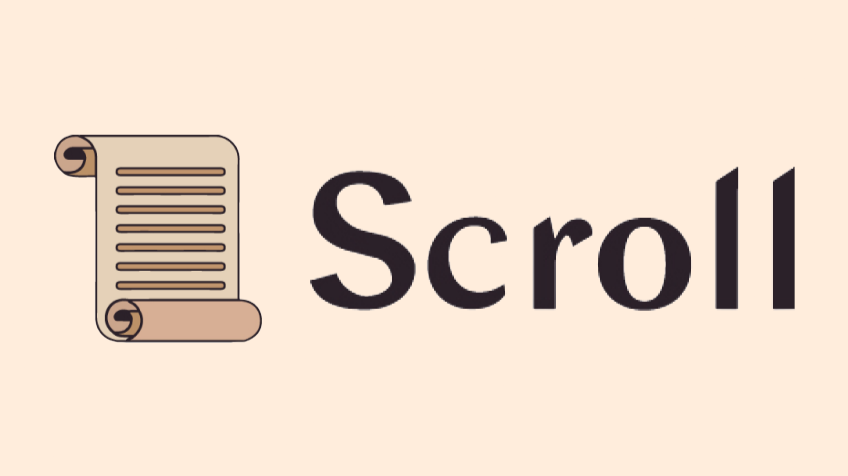
Scroll is a Layer 2 scaling solution for the Ethereum Blockchain.
It positions itself as an open-source, community-driven blockchain helping Ethereum scale through zkEVMs.
zkEVMs are specific types of ZK-rollups compatible with the Ethereum Virtual Machine (EVM).
In addition, it is bytecode-compatible. This means that developers can easily migrate their Dapps from Ethereum to Scroll without any code changes.
With these goals, Scroll aims to make Ethereum more affordable, faster, and highly compatible with its environment.
A team led by Ye Zhang, a cryptographer, Shen Haicheng, a software engineer, and Sandy Peng, a Web 3 developer founded it in 2021.
Then, in October 2023, after thorough testing and refinement, they launched the mainnet, signifying a major milestone.
The team also secured $80 million in funding rounds, setting Scroll’s valuation at a staggering $1.8 billion.
How Does Scroll Work (Scroll Architecture)
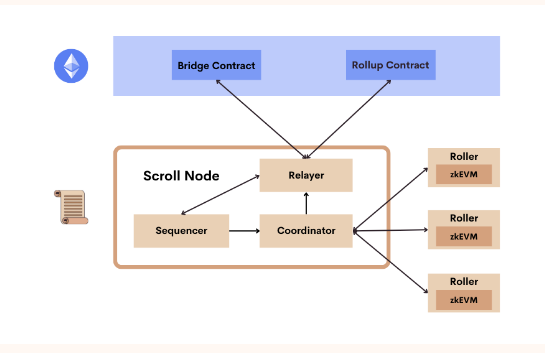
Scroll’s architecture consists of three main components: Scroll Node, Roller Network, Rollup and Bridge Contracts.
Scroll Node
The Scroll node is the main way for applications and users to interact with Scroll
It facilitates user interactions and communication between L1 and L2.
The Scroll Node comprises the Sequencer, Coordinator, and Relayer modules.
The Sequencer processes L2 transactions, and the Coordinator dispatches execution traces to Rollers for a proof generation.
The Relayer monitors contracts on Ethereum and Scroll, ensuring data availability and relaying messages between both sides.
Roller Network
Roller ensures the trust and security of Scroll’s off-chain transactions.
Essentially, it generates the zkEVM validity proofs to prove that transactions are executed correctly.
They work efficiently in the background, allowing Scroll to offer fast and cheap transactions while maintaining Ethereum’s robust security.
Rollup and Bridge Contracts
Rollup and Bridge Contracts in Scroll facilitate data availability for L2 transactions and enable asset and message transfer between Ethereum and Scroll.
The Rollup contract stores state roots and L2 block data in Ethereum, ensuring data availability for Scroll blocks.
On the other hand, the Bridge contracts, enable trustless bridging for users to move ERC-20 assets in both directions.
Thus, serving as essential components for the interoperability and functionality of Scroll’s zkRollup solution
In summary, Scroll combines these three components to run native EVM bytecode on L2 while still maintaining the strong security of Ethereum’s base layer.
For more insights into Scroll architecture and how it works, see this article by Scroll.
Navigating Scroll’s Ecosystem
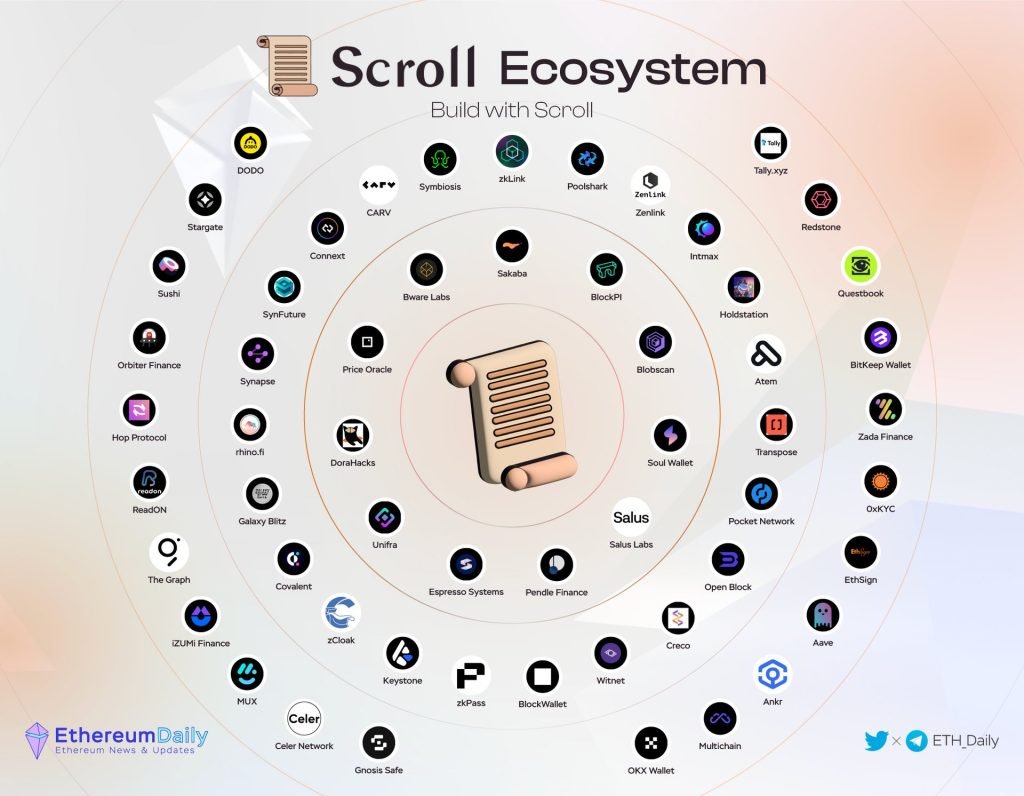
In just months since its mainnet launch, Scroll’s ecosystem has already blossomed with over 100 diverse projects across DeFi, DEXes, NFTs, and Web3.
This remarkable pace of adoption can be credited to its bytecode-level compatibility and EVM equivalence advantage.
Here’s a peek into some key players:
DeFi:
- Scroll Bridge: It’s the official cross-chain bridge of Scroll. The bridge allows users to securely transfer ERC20 (Ethereum) tokens, alone to the Scroll network
- Cog Finance: It’s a lending platform natively built on Scroll. It allows users to lend or borrow from a predefined set of pools
- Sushi: A prominent decentralized exchange (DEX), known for seamless swapping and liquidity incentives
Other popular Defi Dapps on Scroll include Chainge Finance, Orbiter Finance, Kyberswap and Dodo.
NFTs:
- AlienSwap: A multi-chain NFT marketplace and aggregator
- Innovaz: A platform for creators to launch customized NFT marketplaces effortlessly and cost-free
Web3:
- Gnosis Safe: It’s a multi-signature wallet that enhances security for DAOs and individuals, and now adopts the Scroll network for gas-efficient transactions.
- OKX Web3 Wallet: This developer-friendly wallet lets you seamlessly interact with Scroll and other Dapps.
These offer just a glimpse into the thriving ecosystems of over 100 Dapps on Scroll. Moreso, the number is expected to grow as developers embrace its potential.
How To Get Scroll Airdrop

Scroll currently operates without a token, similar to other successful projects like Starknet, and ZKSync.
The team has consistently emphasized prioritizing a robust L2 solution, deferring token considerations for a later time.
However, since the Mainnet launch, the community members have been buzzing and eagerly anticipating an imminent airdrop from Scroll.
Interested in the potential Scroll airdrop? Here is how you can position yourself for it.
- Visit the official website (scroll.io) and click on “Bridge”
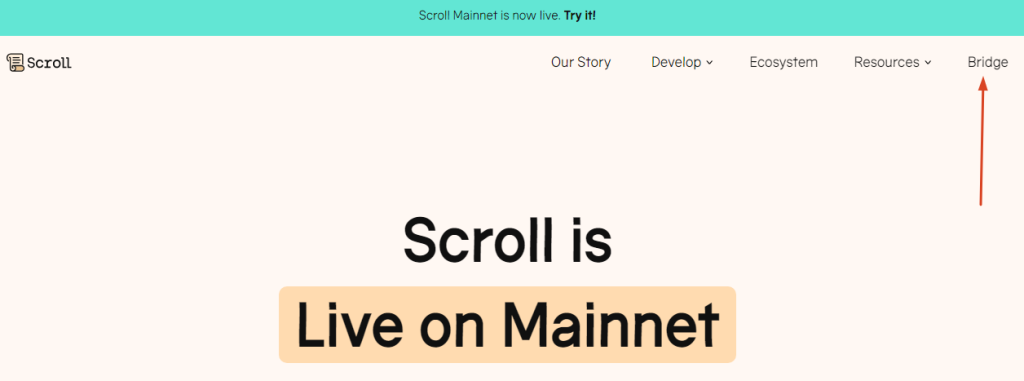
- To continue the next step, you must have acquired some ETH and stored it in your Web3 wallet like Metamask. Connect your wallet, enter the amount of ETH you want to bridge and approve the transaction.

Note: The Scroll bridge exclusively supports the Ethereum network. You can bridge various versions of ETH to Scroll through Orbiter Finance for a cheaper gas fee.
- Once your ETH has been bridged over to Scroll, go over the “Ecosystem” page on the website and interact with a handful of Dapps.
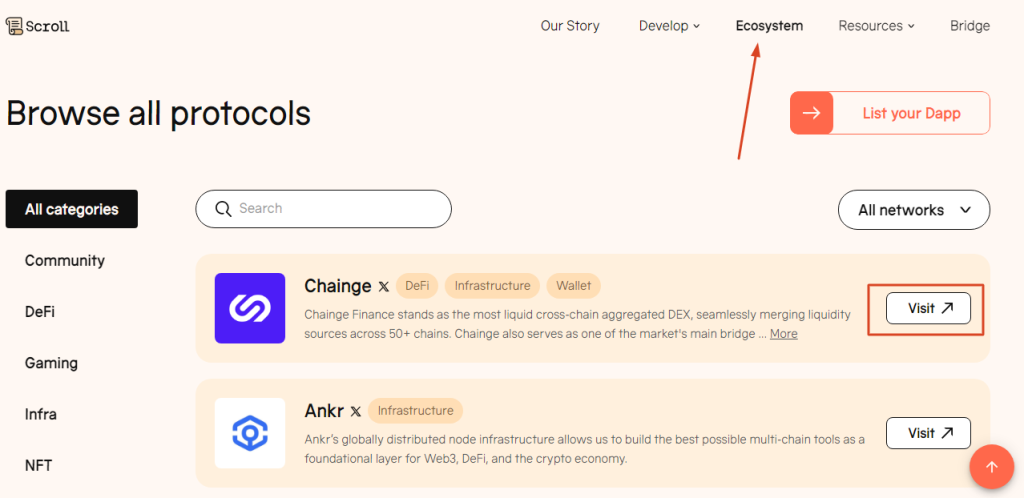
That’s about how to potentially qualify for the airdrop.
Note that whether or not a Scroll airdrop will happen is yet to be determined by the team.
You can stay tuned for further updates by following Scroll on its official social accounts.
Conclusion
Scroll is emerging as a promising Layer 2 solution, inheriting the security of Ethereum while significantly scaling its capabilities.
It boasts significantly lower fees, making it an attractive option for both users and developers.
Besides this, its open-source, decentralized, and community-driven nature fosters trust in the network.
To top it all, Scroll aims to provide developers with a seamless experience for deploying Dapps on a zkEVM, making it appealing for easy adoption.
Even though the team hasn’t confirmed any airdrop plans, exploring the ecosystem is a great way to be a part of the community and experience its innovative technology.
Tell me in the comment section. What do you think about Scroll? Do you think it has the potential to become a major player in the L2 space in the long run?
Enjoyed this post? Share it with your friends by clicking the “SM” buttons below.
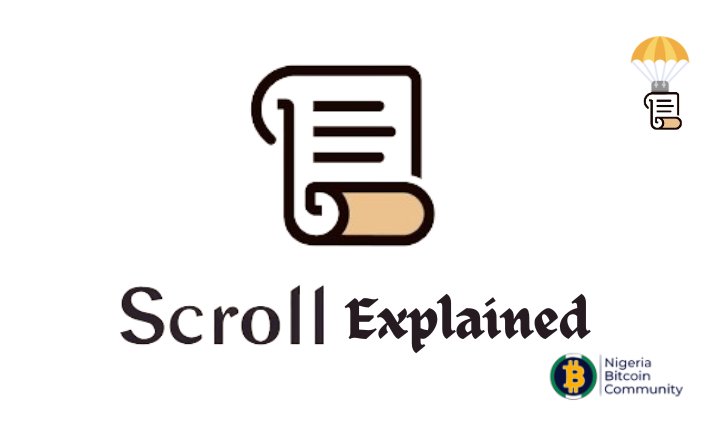


0 Comments